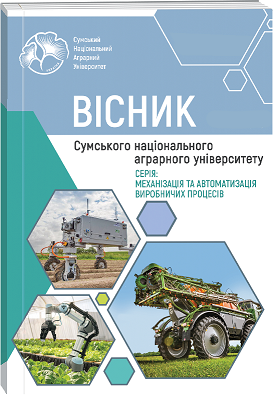ANALYTICAL PROVISIONS OF INFLUENCE OF COMPLETENESS OF TECHNICAL CONTROL ON FAULTLESSNESS OF SELF-PROPELLED SPRAYERS
Abstract
The article discusses the impact of the parameters of built-in technical control, such as the completeness and depth of technical control, on the reliability of self-propelled sprayers. Analytical models of some typical failure-free structures of self-propelled sprayers have been developed, which take into ac-count the characteristics of technical control over the efficiency of the elements. A graphical interpretation of the dependence of the reliability of self-propelled sprayers on the completeness of technical control is presented. The existence of the influence of completeness of technical control on the indicators of failure of structures is confirmed. The considered approach with a similar analysis allows to reasonably make requirements to the characteristics of technical control systems of self-propelled sprayers.
References
2. Gurcanli, E., Bilir, S., Sevim, M. 2015. Activity based risk assessment and safety cost estimation for residential building construction projects. Safety Science 80: 1–12.
3. Khamidullina, E.A., Timofeeva, S.S., Smirnov, G.I. 2017. Accidents in coal mining from perspective of risk theory. IOP Conference Series: Materials Science and Engineering 262: 012210.
4. Aven, T. 2016. Risk assessment and risk management: review of recent advances on their foundation. European Journal of Operational Research 253(1): 1–13.
5. Tyutrin, S. 2019. Improving reliability of parts of mounted mower according to monitoring results by fatigue gauges from tin foil. Engineering for rural development 18: 22–27.
6. Voinalovych, O., Hnatiuk, O., Rogovskii, I., Pokutnii, O. 2019. Probability of traumatic situations in mechanized processes in agriculture using mathematical apparatus of Markov chain method. Engineering for rural development 18: 563–569.
7. Rogovskii, I., Titova, L., Novitskii, A., Rebenko, V. 2019. Research of vibroacoustic diagnostics of fuel system of engines of combine harvesters. Engineering for rural development 18: 291–298.
8. Duan, F., Živanovi´c, R., Al-Sarawi, S., Mba, D. 2016. Induction motor parameter estimation using sparse grid optimization algorithm. IEEE Trans. Ind. Inf 12: 1453–1461.
9. Shih-Heng, T., Ming-Hsiang, S., Wen-Pei, S. 2018. Development of digital image correlation method to analyse crack variations of masonry wall. Sadhana 6: 767–779.
10. Gyansah, L., Ansah, A. 2020. Fatigue crack initiation analysis in 1060 steel. Research journal of applied sciences engineering and technology 4(2): 319–325.
11. Nykyforchyn, H., Lunarska, E., Tsyrulnyk, O. 2019. Environmentally assisted “in-bulk” steel degradation of long term service gas trunkline. Engineering Failure Analysis 17: 624-632.
12. Corinne, B., José, R. 2017. Estimating the Hurst parameter. Statistical Inference for Stochastic Processes. Springer Verlag, 10(1): 49–73.
13. Kypris, O., Nlebedim, I., Jiles, D. 2016. Measuring stress variation with depth using Barkhausen signal. Journal of Magnetism and Magnetic Materials – Science Direct 407: 377–395.
14. Erokhin, M., Pastukhov, A., Kazantsev, S. 2019. Operability assessment of drive shafts of John Deere tractors in operational parameters. Engineering for rural development 18: 28–33.
15. Xi, L., Songlin, Z. 2019. Changes in mechanical properties of vehicle components after strengthening under low-amplitude loads below the fatigue limit. Fatigue and Fracture of Engineering Materials and Structures 32(10): 847–855.
16. Rejovitzky, E., Altus, E. 2013. On single damage variable models for fatigue. International Journal of Damage Mechanics 22(2) 2: 268–284.
17. Pisarenko, G., Voinalovych, O., Rogovskii, I., Motrich, M. 2019. Probability of boundary exhaustion of resources as factor of operational safety for agricultural aggregates. Engineering for rural development 18: 291–298.
18. Sánchez-Hermosilla, J., Rincón, V., Páez, F. 2011. Field evaluation of a self-propelled sprayer and effects of the application rate on spray deposition and losses to the ground. Pest Management Science 67(8): 942–947.
19. Kalinichenko, D., Rogovskii, I. 2017. Modeling technology in centralized technical maintenance of combine harvesters. TEKA 17(3): 93–102.
20. Zou, F., Kang, J., Xiao, M., Ji, G. 2017. Hydrostatic driving system for self-propelled sprayer. Engineering Journal 26(3): 12–18.
21. Rogovskii, I. 2020. Algorithmicly determine the frequency of recovery of agricultural machinery according to degree of resource's costs. Machinery & Energetics. Journal of Rural Production Research 11(1): 155–162.
22. Chen, Y., Mao, E., Li, W., Chen, J. 2020. Design and experiment of a high-clearance self-propelled sprayer chassis. International Journal of Agricultural and Biological Engineering 13(2): 71–80.

 ISSN
ISSN  ISSN
ISSN 



